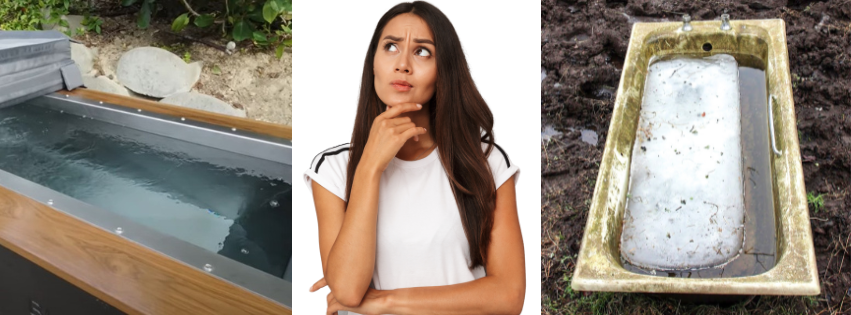
Three years ago, I was shivering in my bathtub filled with garden-store ice, wondering if I’d made a huge mistake. Today, as I guide others through their cold therapy journeys at my Oregon coast workshops, that memory makes me smile.
Whether you’re drawn to cold therapy for physical recovery, mental clarity, or spiritual growth, choosing between a cold plunge vs ice bath isn’t just about equipment – it’s about matching the method to your current place on the path.
First, a definition:
Contents
- 1 What? Cold Plunge vs Ice Bath
- 2 My Cold Therapy Evolution: From Bathroom Ice Baths to Cold Plunge Living
- 3 Making Your Choice: A Mindful Approach
- 4 Safety Mindset: A Non-Negotiable at Every Stage
- 5 The Mindfulness Connection: Beyond the Equipment
- 6 Frequently Asked Questions From My Workshop Students
- 7 Future-Proofing Your Cold Therapy Journey
- 8 Making Your Final Decision
- 9 Key Takeaways
- 10 Ready to explore specific options for your chosen path?
What? Cold Plunge vs Ice Bath
An ice bath typically refers to a compact, vertical-style tub with a smaller footprint, usually round or oval in shape. These systems range from simple setups like stock tanks, plus water and ice, to dedicated cold therapy tubs with add-on water chiller systems.
Ice baths are ideal for beginners due to their accessibility, minimal space requirements, and straightforward setup options.
In contrast, a cold plunge is characterized by its full-length, horizontal design that allows for complete body submersion in a lying position.
While cold plunge vs ice bath serve similar therapeutic purposes, cold plunges often feature more sophisticated temperature control systems and filtration, making them a more permanent installation.
The key differences lie in:
- Setup complexity: Basic to intermediate vs. intermediate to advanced
- Design: Vertical (ice bath) vs. horizontal (cold plunge)
- Footprint: Compact vs. full-length
- Installation: Temporary/mobile vs. permanent
FURTHER READING >
>>See Marcus’s top 7 portable ice baths for his favorites or my best ice bath tubs to include less mobile models with chiller options.<<
>>Check out Johnny’s definitive list for the best cold plunge tub for you<<
My Cold Therapy Evolution: From Bathroom Ice Baths to Cold Plunge Living
Like many of you, my journey began with a bathtub and bags of ice. Each stage revealed not just the practical differences between setups, but more importantly, helped me understand which solution best matches different commitment levels. Let me walk you through my experience, so you can identify where you are on your cold therapy path.
Stage 1: The DIY Bathroom Beginning (Months 0-3)
My first cold immersion experience was exactly what you might imagine – me, my bathtub, and eight bags of ice from the local store. I’d been practicing Wim Hof breathing for months, but nothing truly prepared me for that first plunge. The setup was basic:
• Standard bathtub
• Store-bought ice (lots of it)
• Good thermometer
• Timer on my phone
• Determination (and maybe a little fear)
What I Learned:
- Temperature control was inconsistent
- Setup took 30+ minutes
- Ice runs became a daily challenge
- Cleanup was messy
- But… it was enough to prove the benefits were real
Perfect for: Complete beginners testing the waters or occasional users
Stage 2: The Portable Ice Bath Phase (Months 3-8)
As my practice deepened and I found myself craving daily sessions, the bathtub setup became unsustainable. I invested in a portable ice bath, which brought new possibilities:
Benefits I Discovered:
- Dedicated space for practice
- Better temperature retention
- More comfortable positioning
- Easier cleaning process
- Professional appearance for client sessions
Challenges That Remained:
- Still needed regular ice
- Temperature fluctuations
- Limited immersion time
- Storage considerations
Perfect for: Regular practitioners ready for a dedicated solution but not prepared for permanent installation
Stage 3: The Upgraded Ice Bath System (Months 8-18)
This was the game-changing middle ground I wish I’d known about sooner. Adding a water chiller and upgrading to a less mobile but better insulated ice bath transformed my practice:
Key Improvements:
- Consistent temperature control
- Reduced ice dependency
- Longer immersion options
- Professional-grade experience
- More sustainable long-term solution
What Changed in My Practice:
- More consistent session times
- Deeper meditation possible
- Better recovery tracking
- Increased confidence in guiding others
The Technical Evolution
- Added water chiller system
- Much improved insulation
- Digital temperature control
- More efficient energy use
Perfect for: Serious practitioners who want reliability without full cold plunge investment
Stage 4: The Cold Plunge Commitment (18+ months)
When cold therapy became as essential to my daily routine as morning meditation, I made the leap to a dedicated cold plunge system:
Complete System Benefits:
- Set-and-forget temperature control
- Professional filtration
- Elegant aesthetic
- Year-round reliability
- Minimal maintenance
The Investment Consideration:
- Higher initial cost
- Installation requirements
- Dedicated space needed
- Long-term value
- Energy efficiency
Perfect for: Dedicated practitioners who’ve made cold therapy a lifestyle
Making Your Choice: A Mindful Approach
Consider Your Current Stage:
🌱 Exploration Phase
- Start with DIY setup
- Focus on technique
- Build tolerance
- Minimal investment
🌿 Growth Phase
- Portable ice bath
- Regular practice
- Building consistency
- Medium investment
🌳 Commitment Phase
- Chiller system addition
- Daily practice
- Temperature control
- Significant investment
🎋 Lifestyle Integration
- Cold plunge system
- Full commitment
- Maximum convenience
- Long-term investment
Practical Considerations for Each Stage
| Setup Type | Initial Cost | Daily Prep Time | Temperature Control | Best For… |
| DIY Bath | $ | 30+ mins | Basic | Beginners |
| Portable | $$ | 15-20 mins | Better | Regular Users |
| Chiller System | $$$ | 5-10 mins | Excellent | Dedicated Users |
| Cold Plunge | $$$$ | 1-2 mins | Excellent | Lifestyle Integration |
Making Your Decision: Key Questions to Ask
- How often will you practice?
- What’s your available space?
- What’s your budget comfort zone?
- How important is temperature consistency?
- Do you need portability?
Safety Mindset: A Non-Negotiable at Every Stage
Drawing from my yoga background, I always emphasize that safety isn’t just about physical protection – it’s about creating the right mental and environmental conditions for practice.
Essential Safety Practices:
- Never practice alone when starting
- Begin with 1-2 minute sessions
- Focus on steady breathing
- Exit at first sign of severe discomfort
- Stay well-hydrated
- Avoid cold exposure when ill
The Mindfulness Connection: Beyond the Equipment
As a breathwork practitioner, I’ve found that the type of setup you choose can significantly impact your ability to maintain mindfulness during sessions:
DIY Setup Mindfulness
- Requires extra focus on comfort
- Can distract from practice
- Good for building mental resilience
- Teaches patience through preparation
Portable Setup Mindfulness
- More focus on actual practice
- Better positioning for meditation
- Still requires preparation mindfulness
- Builds routine awareness
Chiller System Mindfulness
- Enhanced focus on breath
- Deeper meditation possible
- Temperature consistency aids practice
- Better alignment with daily rituals
- Full presence in practice
- Optimal meditation environment
- Integration with other practices
- Supports spiritual development
Frequently Asked Questions From My Workshop Students
Temperature Management
Q: “What’s the ideal temperature for beginners?”
A: I recommend starting at 55°F (13°C) and gradually working down to 45°F (7°C). Each setup type offers different temperature control capabilities:
- DIY: Variable (45-60°F)
- Portable: Dependent on ice (45-55°F)
- Chiller System: Consistent (38-55°F)
- Cold Plunge: Precise (35-55°F)
Q: “How do you maintain temperature consistency?”
A: This varies by setup:
- DIY: Regular ice addition and monitoring
- Portable: Ice management and insulation
- Chiller System: Automated temperature control
- Cold Plunge: Built-in temperature management
Practice Development
Q: “How often should I practice?”
A: Start with 2-3 sessions per week, increasing as your body adapts. Your setup choice should align with your frequency goals:
- DIY: Best for 1-2 weekly sessions
- Portable: Supports 2-4 weekly sessions
- Chiller System: Enables 4-6 weekly sessions
- Cold Plunge: Perfect for daily practice
Investment Considerations
Q: “Is it worth upgrading from DIY to a dedicated setup?”
A: Consider these factors:
- Time value (setup/cleanup)
- Practice consistency
- Long-term cost (ice/energy)
- Commitment level
- Available space
Future-Proofing Your Cold Therapy Journey
As someone who’s progressed through each stage, here’s my advice for sustainable practice:
Beginning Stage (0-3 months)
- Start with accessible options
- Focus on technique development
- Monitor your commitment level
- Track your response to cold exposure
Development Stage (3-12 months)
- Consider convenience factors
- Evaluate practice consistency
- Assess space requirements
- Monitor cost versus usage
Advanced Stage (12+ months)
- Think long-term sustainability
- Consider aesthetic integration
- Evaluate maintenance needs
- Plan for daily practice
Making Your Final Decision
Remember, there’s no “wrong” choice – only the choice that best matches your current stage. I’ve found that the most successful practitioners are those who:
- Honor their current commitment level
- Choose setups that fit their lifestyle
- Focus on consistency over intensity
- Allow their practice to evolve naturally
- Invest progressively as their practice deepens
Key Takeaways
✓ Start where you are – every setup type has its place
✓ Match your equipment to your commitment level
✓ Consider the full cost of ownership
✓ Factor in your available time and space
✓ Plan for practice evolution
Ready to explore specific options for your chosen path?
• Marcus’s guide to the best portable ice baths known to man (or woman) >>
• My guide to all of the best ice bath options out there >>
• Considering a chiller system? Let Greg guide you through the tech step-by-step >>
• Prepared for full commitment? Johnny takes you to the cold plunge high ticket options >>
This website may contain affiliate links. As an affiliate, we may earn a commission from qualifying purchases at no additional cost to you.
